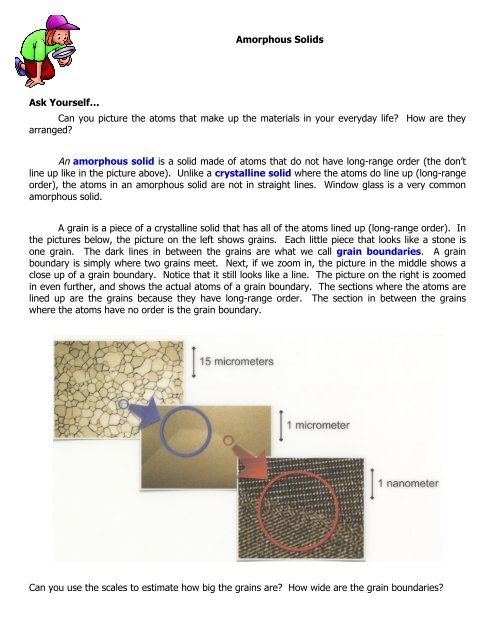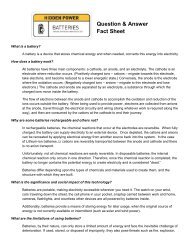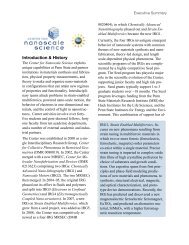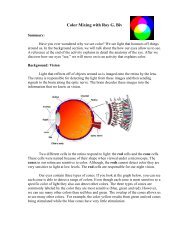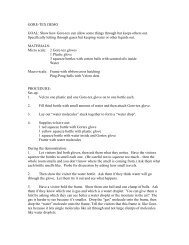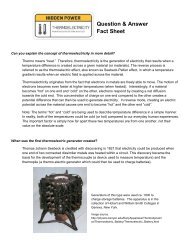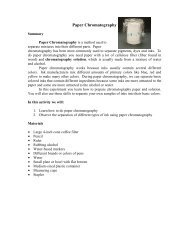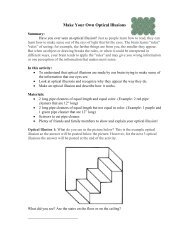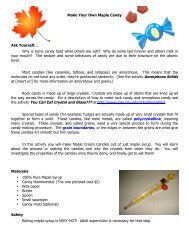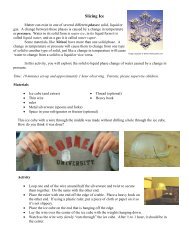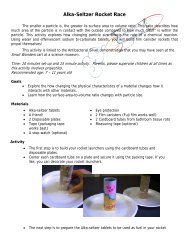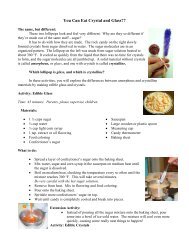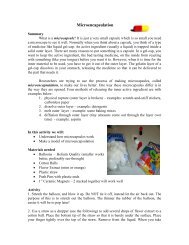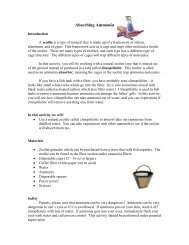Amorphous Solids Ask Yourself⦠Can you picture the atoms that ...
Amorphous Solids Ask Yourself⦠Can you picture the atoms that ...
Amorphous Solids Ask Yourself⦠Can you picture the atoms that ...
You also want an ePaper? Increase the reach of your titles
YUMPU automatically turns print PDFs into web optimized ePapers that Google loves.
<strong>Amorphous</strong> <strong>Solids</strong><br />
<strong>Ask</strong> Yourself…<br />
<strong>Can</strong> <strong>you</strong> <strong>picture</strong> <strong>the</strong> <strong>atoms</strong> <strong>that</strong> make up <strong>the</strong> materials in <strong>you</strong>r everyday life? How are <strong>the</strong>y<br />
arranged?<br />
An amorphous solid is a solid made of <strong>atoms</strong> <strong>that</strong> do not have long-range order (<strong>the</strong> don’t<br />
line up like in <strong>the</strong> <strong>picture</strong> above). Unlike a crystalline solid where <strong>the</strong> <strong>atoms</strong> do line up (long-range<br />
order), <strong>the</strong> <strong>atoms</strong> in an amorphous solid are not in straight lines. Window glass is a very common<br />
amorphous solid.<br />
A grain is a piece of a crystalline solid <strong>that</strong> has all of <strong>the</strong> <strong>atoms</strong> lined up (long-range order). In<br />
<strong>the</strong> <strong>picture</strong>s below, <strong>the</strong> <strong>picture</strong> on <strong>the</strong> left shows grains. Each little piece <strong>that</strong> looks like a stone is<br />
one grain. The dark lines in between <strong>the</strong> grains are what we call grain boundaries. A grain<br />
boundary is simply where two grains meet. Next, if we zoom in, <strong>the</strong> <strong>picture</strong> in <strong>the</strong> middle shows a<br />
close up of a grain boundary. Notice <strong>that</strong> it still looks like a line. The <strong>picture</strong> on <strong>the</strong> right is zoomed<br />
in even fur<strong>the</strong>r, and shows <strong>the</strong> actual <strong>atoms</strong> of a grain boundary. The sections where <strong>the</strong> <strong>atoms</strong> are<br />
lined up are <strong>the</strong> grains because <strong>the</strong>y have long-range order. The section in between <strong>the</strong> grains<br />
where <strong>the</strong> <strong>atoms</strong> have no order is <strong>the</strong> grain boundary.<br />
<strong>Can</strong> <strong>you</strong> use <strong>the</strong> scales to estimate how big <strong>the</strong> grains are? How wide are <strong>the</strong> grain boundaries?
In this experiment, <strong>you</strong> will make a large-scale model of <strong>the</strong> <strong>atoms</strong> of a single grain, and <strong>the</strong>n<br />
an amorphous solid. Finally, <strong>you</strong> will model a grain boundary between two grains.<br />
Materials<br />
• Large kitchen bowl<br />
• Two sizes of round candies*<br />
• Shoe box<br />
*<strong>Can</strong>dies should be different in size, but<br />
larger candy should be no more than 3 times<br />
larger than <strong>the</strong> small candy. Both types of<br />
candy should be perfectly round.<br />
Gobbstoppers (for <strong>the</strong> smaller) and<br />
Whoppers (for <strong>the</strong> larger) work well. If <strong>you</strong><br />
have <strong>the</strong>m, marbles and BBs work well.<br />
Safety<br />
Caution should be taken when shaking <strong>the</strong> model.<br />
Activity<br />
First, <strong>you</strong> will make a large-scale model of a crystalline solid. To begin, pour enough of <strong>the</strong><br />
smaller candy into <strong>the</strong> bowl to cover <strong>the</strong> bottom with one layer<br />
of candy. Each candy represents one atom. Gently shake <strong>the</strong><br />
bowl from side to side and watch how <strong>the</strong> “<strong>atoms</strong>” move. Keep<br />
shaking until all of <strong>the</strong> <strong>atoms</strong> line up in straight lines, as seen in<br />
<strong>the</strong> <strong>picture</strong> to <strong>the</strong> right.<br />
What do <strong>you</strong> notice? How many directions of ordering<br />
can <strong>you</strong> find? Do any of <strong>the</strong> rows of <strong>atoms</strong> go all <strong>the</strong> way from<br />
one side to <strong>the</strong> o<strong>the</strong>r? What happens at <strong>the</strong> edges? Write<br />
down <strong>you</strong>r observations.<br />
This is a large-scale model of a single grain. Notice <strong>that</strong> this model has long-range order<br />
because <strong>the</strong> rows of <strong>atoms</strong> continue across <strong>the</strong> grain. This is how <strong>the</strong> <strong>atoms</strong> are arranged in a grain<br />
of typical metals. Is this how <strong>you</strong> <strong>picture</strong>d <strong>the</strong> <strong>atoms</strong> in <strong>you</strong>r spoon? Your fork?<br />
Next, <strong>you</strong> will make a large-scale model of <strong>the</strong> <strong>atoms</strong> in an amorphous solid. Take <strong>the</strong> bowl<br />
with <strong>the</strong> small <strong>atoms</strong>, and add <strong>the</strong> bigger <strong>atoms</strong> (<strong>the</strong> larger size candy). You do not need as many of<br />
<strong>the</strong> bigger <strong>atoms</strong>, estimate one fourth to one third <strong>the</strong> number of small <strong>atoms</strong>. Mix <strong>the</strong> <strong>atoms</strong> up<br />
with <strong>you</strong>r hands until all <strong>the</strong> big <strong>atoms</strong> have been distributed. Again, gently shake <strong>the</strong> mixture back<br />
and fourth and watch what happens to <strong>the</strong> <strong>atoms</strong>. They should start to look something like <strong>the</strong><br />
<strong>picture</strong> on <strong>the</strong> right.
<strong>Can</strong> <strong>you</strong> get <strong>the</strong>m to line up again? If <strong>you</strong> can’t get lines<br />
of <strong>atoms</strong> <strong>that</strong> go all <strong>the</strong> way across, how many <strong>atoms</strong> do line<br />
up? You may be able to get a couple of <strong>the</strong> small <strong>atoms</strong> to line<br />
up. This is called short-range order and also occurs in<br />
amorphous solids. Scientists adjust <strong>the</strong> number of small and<br />
big <strong>atoms</strong> when <strong>the</strong>y’re making amorphous solids to decrease<br />
short-range order. If <strong>you</strong> add more of <strong>the</strong> big candy and shake<br />
it again does <strong>the</strong> short-range order disappear? When <strong>you</strong>’re<br />
done, separate <strong>the</strong> small and big candy for <strong>the</strong> next step.<br />
Now <strong>you</strong>’re going to make a model of a grain boundary. Pour just <strong>the</strong> small candy into <strong>the</strong><br />
shoebox. To make a grain boundary <strong>you</strong> need to get two areas where <strong>the</strong> <strong>atoms</strong> are lined up in<br />
different directions. Each area will be a grain. To do this, hold <strong>the</strong> box with one corner facing down.<br />
Gently shake <strong>the</strong> box until <strong>you</strong> have just one layer of <strong>atoms</strong>.<br />
Continue shaking gently and watch how <strong>the</strong> <strong>atoms</strong> move.<br />
Eventually <strong>you</strong> should have rows of <strong>atoms</strong> along <strong>the</strong> two sides<br />
of <strong>the</strong> box. These two areas with long-range order are <strong>you</strong>r<br />
grains. <strong>Can</strong> <strong>you</strong> see <strong>the</strong> grain boundary down <strong>the</strong> middle? Mix<br />
<strong>the</strong> <strong>atoms</strong> up and try it again. Is <strong>the</strong> grain boundary in <strong>the</strong><br />
same place? What do <strong>you</strong> notice is different? <strong>Can</strong> <strong>you</strong> get <strong>the</strong><br />
<strong>atoms</strong> to line up on both edges without a grain boundary?<br />
(This would mean <strong>you</strong> have one grain.)<br />
Extension Activity<br />
Try to add ano<strong>the</strong>r layer of “<strong>atoms</strong>” to <strong>the</strong> model for both <strong>the</strong> crystalline and amorphous<br />
models in <strong>the</strong> bowl. Do this by adding more candy and shaking with <strong>the</strong> same method. What do <strong>you</strong><br />
see in <strong>the</strong> top layer? Is <strong>the</strong>re long-range or short-range order?<br />
Try <strong>the</strong> experiment again using o<strong>the</strong>r types of <strong>atoms</strong>. Does it make a difference if <strong>the</strong> two<br />
candies are closer in size? What about if one candy is much bigger than <strong>the</strong> o<strong>the</strong>r?<br />
Summary<br />
You have just modeled a single grain, two grains with a grain boundary, and an amorphous<br />
solid. These different arrangements of <strong>atoms</strong> on <strong>the</strong> nano-scale lead to some very different<br />
behaviors of <strong>the</strong> materials on <strong>the</strong> large-scale. The grain boundaries <strong>you</strong> modeled are really much too<br />
small to see with <strong>the</strong> naked eye, but <strong>the</strong>y give <strong>the</strong> materials properties <strong>that</strong> we can test and use.<br />
<strong>Amorphous</strong> solids (with no grain boundaries) have some pretty cool properties. Check out some of<br />
<strong>the</strong> o<strong>the</strong>r activities in this section to learn more about crystalline and amorphous solids!


